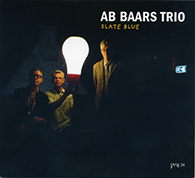
Ab Baars Trio
Slate Blue
(Wig)
Once again, I’ll mention the "permanent
revolution" tag coined by US critic Francis Davis – in its original use,
when talking about the music of Ornette Coleman – as related to avant-garde art
whose formal innovations have not been absorbed by the mainstream; the logical
implication being, of course, that avant-garde art will never become a part of
the mainstream.
While making readers aware that the Ab Baars trio – whose
line-up has Wilbert de Joode’s double bass and Martin van Duynhoven’s drums
appearing alongside the leader’s tenor sax, clarinet, and shakuhachi – started
in 1990, Slate Blue’s liner notes implicitly invite the listener to measure the
progress made by this trio, also its unvarying distance from the
"landscape".
Slate Blue was recorded live – if with, or without, any
audience in attendance I can’t say, the only sounds I heard on the recording
being those produced by the performers – on March 6, 2014 at Splendor
Amsterdam. Crystal-clear recorded sound by Micha de Kanter, as per his usual,
Slate Blue was mixed and edited by de Kanter, Ab Baars, and Ig Henneman, who
also acted as the producer. Here I think that the logic underlying the
production work was to stress the "formal" side of the performances,
so as to make their compositional side more apparent, with "cut"
endings and an approach to mixing designed to highlight the
"deliberate" nature of what one is listening to.
I found the bass sound to be both "fuller" and
"jazz-like" than in the past (the instrument that’s featured here
being a different one from the one I remember). The drums sound great, with a
very musical-sounding snare drum, deep-sounding bass drum and floor tom, and
appropriately lively cymbals.
I’m gonna transcribe an excerpt from the quite succinct
press release that came with the CD, a passage that doesn’t appear in the
album’s liner notes: "Slate Blue is a collection of newly written
compositions by Ab Baars. These compositions and improvisations were inspired
by the music of French composer Olivier Messiaen for which Baars has a deep
passion."
TA-DA!
(Will wonders ever cease?)
It goes without saying that the music featured on this
album can’t be filed under "easy listening". An austere mood, the
clarinet as the main instrument, the "absence" of any audience, the
use of written parts, which – maybe I’m wrong – I felt could be detected here
and there, Slate Blue needs a lot of silence to be appreciated, and I don’t
mean only of the inner kind. Nice instrumental palette, which here and there
reminded me of (US trio) Air, but (obviously) without the Blues.
Ten tracks, the album’s total length being not too far
from that of an old vinyl LP, let’s have a quick look at those pieces.
Opening track Hout features the clarinet. The main figure
here appears to be a sequence of notes going in pairs, which is echoed by drums
and double bass. A "swinging" attitude from the rhythm section, which
works "against" the soloist. In closing, the "theme", with
a "cut" ending.
Oestermes features the clarinet. Again, the rhythm section
plays "against" the soloist, but it’s easy at times to catch signs
and cells that are passed from the clarinet to the rhythm section.
"Theme", and a "cut" ending.
Water features the tenor sax. There’s a
"jazz-related" theme, with a "walking" backing from the
double bass. Here the "grammar" reminded me a bit of Anthony Braxton,
but with a different sound. Also US trio Air, but with less lyricism. Theme,
close.
At 6′ 14", Steen, featuring the clarinet, is the
album’s longest track. There’s a long intro from drums and cymbals, with many
variations in both volume and tempo, then double bass and clarinet, almost
acting as a pedal. Drums again, the pedal again, then a fine close with
beautiful-sounding cymbals.
Kauw features a "hushed" tenor sax with fine
backing by double bass and drums played brushes – "Air minus swing".
The rhythm section gains speed, then the calm.
Karmozijn is the album’s only track featuring the
shakuhachi, an acceleration of the blowing sound acting as a kind of theme.
Double bass played arco, with dry, deep hits from the drums.
The tenor sax is featured on Fanfare, but here the
"fanfare" inhabits the lazy tempo of, say, ‘Round Midnight. There’s a
fine snare, then the double bass plays a solo – here I think the mics of the
other instruments are switched off, with a "close up" effect. In
closing, the fine theme again.
Featuring the clarinet, Rode Wurger reminded me of the
"minimalism" of a composition such as Thelonious. A
"dancing" kind of theme, with "fat" toms and the double
bass as fine backing. A "light" moment, so to speak, that could work
well as a concert’s encore.
Featuring the tenor sax, Raaf presents an
"aviary"-like mood, with overtones and squeaks from the tenor. Fast
tenor sax arpeggios, I was reminded of some Rova Saxophone Quartet tracks
penned by Jon Raskin. A theme, the rhythm section coming to the fore, then a
solo with a "swing"-like kind of backing, close.
Taan features a "hushed" clarinet, arco bass,
and dark toms. A "lyrical"-sounding piece, of the
"abstract" kind.
Beppe Colli
© Beppe Colli 2015
CloudsandClocks.net
| May 5, 2015


